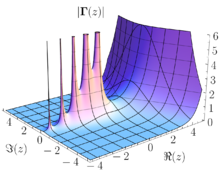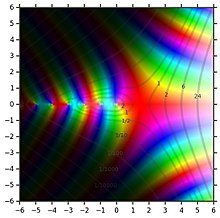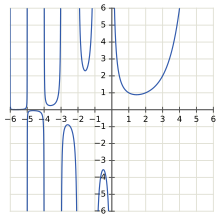Gamma function
The Eulerian gamma function, also known as the gamma function or Eulerian integral of the second genus, is one of the most important special functions and is studied in the mathematical subfields of calculus and function theory. It is represented today by a Γ 
for any natural number 

The gamma function underlies the gamma probability distribution.

magnitude of the complex gamma function

Complex gamma function: The brightness corresponds to the magnitude, the color to the argument of the function value. Additionally, contour lines of constant magnitude are drawn.

Graph of the gamma function in the real
Classification without prior mathematical knowledge
A mathematical function is basically like a calculator. You enter a value into the function, and it then returns a result depending on the input value, at least in theory. What is meant by this is that the function itself does not calculate, but mostly just holds a calculation rule in a formulaic way. A simple example of a function is the quadratic function, which multiplies the input by itself. Formulaically, this is written as 




The gamma function is based on a rule also known as the factorial. This assigns to a natural number the product of all natural numbers up to this number. The factorial is denoted by the symbol of the exclamation mark. So for example
It was considered a problem within mathematics whether this rule could be extended to numbers of other kinds. Concretely, this means:
- Can factorials also be calculated for arbitrary rational, real, complex numbers? How about you could think of
?
- If such "universal" rules are found, what mathematical properties can be given to them? Does one of these prescriptions stand out as being particularly natural and structural? Is this particular precept uniquely determined, i.e. "the one" generalized factorial?
The answer to these questions is provided by the gamma function. For any value 






It then holds 

History
The earliest definition of the gamma function is considered to be that given in a letter from Daniel Bernoulli to Christian Goldbach on 6 October 1729:
for infinitely large 


which Gauss rediscovered in 1812 for the more general case of complex numbers (the letters mentioned were not published until 1843). It approaches with increasing 



This definition was later preferred by Euler and goes by the substitution 
about. Euler discovered this integral while studying a problem from mechanics in which the acceleration of a particle is considered.
In 1809, Adrien-Marie Legendre introduced the Greek majuscule Γ 






Questions and Answers
Q: What is the gamma function in mathematics?
A: The gamma function is a key topic in the field of special functions in mathematics.
Q: What is the extension of the factorial function to all complex numbers except negative integers?
A: The gamma function is an extension of the factorial function to all complex numbers except negative integers.
Q: How is the gamma function defined for positive integers?
A: For positive integers, the gamma function is defined as Γ(n) = (n-1)!.
Q: Is the gamma function defined for all complex numbers?
A: Yes, the gamma function is defined for all complex numbers.
Q: Is the gamma function defined for negative integers and zero?
A: No, the gamma function is not defined for negative integers and zero.
Q: How is the gamma function defined for a complex number whose real part is not a negative integer?
A: The gamma function is defined for a complex number whose real part is not a negative integer by a specific formula that is not given in the text.
Q: Why is the gamma function important in mathematics?
A: The gamma function is important in mathematics because it is a key topic in the field of special functions and it extends the factorial function to all complex numbers except negative integers.
Search within the encyclopedia





